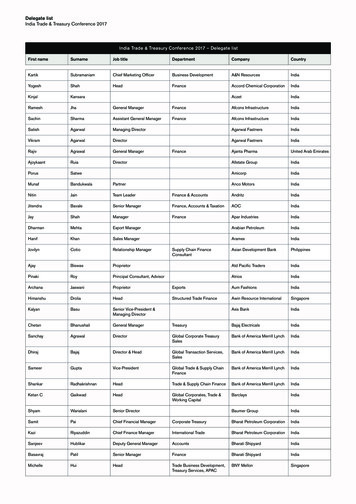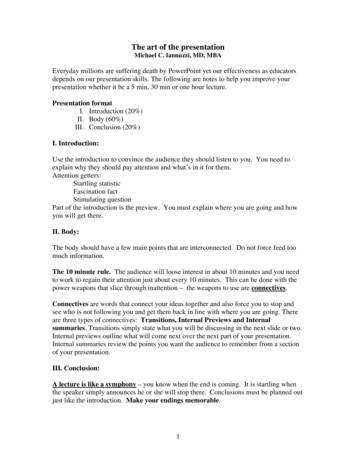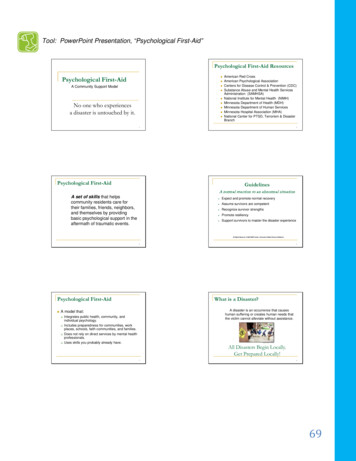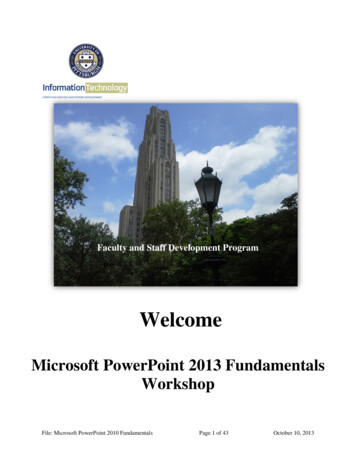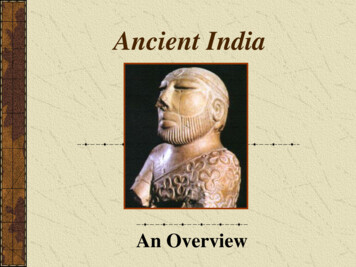
Transcription
Ancient IndiaAn Overview
IntroductionThe Big IdeaIndian civilization first developed on theIndus River.Main IdeasThe geography of India includes highmountains, great rivers, and heavyseasonal rain.Harappan civilization developed alongthe Indus River.The Aryan invasion of India changedthe region’s civilization.
Basic chronologyc. 3000 BCE: farming settlementsappear along the valley of theriver Indusin what is now Pakistanc. 2500 BCE: high point of theIndus Valley civilizationc. 2000 BCE: some Indus sitesshowing signs of declinec. 1500 BCE: the Aryaninvasions
Timeline
Geography of India India is a subcontinent,separated from the rest of theAsian continent by theHimalayas. India can bedivided in two, the northernplains, a flat low plain and theDeccan, a land with manyhills. In northwest India is theThar Desert. The Himalayasprovided natural protectionfrom northern invasions. TheIndian Ocean and the ArabianSea provided protection forthe west and the east.
FYIHistorically, India’s geographicboundaries were bigger than they aretoday Bangladesh India Pakistan IndiaBangladesh and Pakistan did notexist as separate countries until afterIndia gained independence fromGreat Britain in 1947“Northwest India” generally meansPakistanAncient Indian cities, such asHarappa and Mohenjo-daro, arelocated in what is now Pakistan
Indian Geography
The Indus ValleyThe Indus River is locatedin Pakistan. Find it on themap. It was along thisriver that a civilizationdeveloped around 2,500BCE. It is called theIndus Valley Civilization.Two major cities of thiscivilization were Harappaand Mohenjo-Daro.
The River SystemThe main river inAncient India wasthe Indus River.The Indus Riverdeposited fertilesoil during annualflooding. Thesource of the IndusRiver is in theHimalayas.
Indus Valley CultureThe people of the IndusValley were mostlypeaceful farmers. Theybuilt large cities withordered streets and bricksmade all the same size.This indicates they had astrong centralgovernment. This statueis probably a priest orking.
Indus Valley civilizationHere is a reconstruction ofwhat the entrance toMohenjo Daro might havelooked like.Archaeologists discovered two4000-year-old cities, 400 milesapart, along the banks of the IndusRiver in Pakistan. These expertlyconstructed cities were parts of anadvanced civilization comparableto ancient Mesopotamia andEgypt. We don't know what theancient people of the Indus RiverValley called themselves.Archaeologists named the citiesMohenjo-Daro, which means "hillof the dead," and Harappa, after anearby city.
Indus Valley civilizationRight: artist’s recreationof Mohenjo-DaroBelow: Great Bath ruins
Mohenjo-Daro and HarappaThe people of Mohenjo-Daro andHarappa lived in sturdy brick houseswith as many as three floors. Thehouses had bathrooms that wereconnected to sewers. Their elaboratedrainage system was centuries aheadof their time. Archaeologists havefound the remains of fine jewellery,including stones from far away places.This shows that the people of theIndus Valley civilization valued artand traded with other cultures.
Mohenjo-DaroThe Indus Valley builtwalls around their citieswhich indicated that theymight have had to defendthemselves against otherpeople. We do not knowa lot about them becausewe cannot yet read theirwriting.
Everyday life
Mysterious signifiersExamples of themultitude of Harrapanclay seals whosemeaning(s) still elude us.
Indus Valley ScriptHere are several examplesof Indus Valley writing. Itis believed that the IndusValley people may havealso written on palm leavesor cloth but no evidence ofthis has survived.
Indus Valley civilizationWe don't know whathappened to the Indus RiverValley civilization. It seemsto have been abandonedabout 1700BC. It is possiblethat a great flood weakenedthe civilization. The movingtectonic plates that createdthe Himalayas may havecaused a devastatingearthquake. It is also possiblethat the people may havebeen defeated by anotherculture.
Aryan invadersAround 1500 BCE, a group ofnomadic warrior-herders crossed thenarrow Khyber Pass in the HinduKush Mountains and invaded theIndus Valley culture. These people,the Aryans, came from EasternEurope between the Black Sea andCaspian Sea, probably looking forpastures for their animals. Floodingand earthquakes had weakened theIndus Valley culture and they wereunable to withstand the newcomers.
Two cultures combineThe Aryans brought with themtheir own language, called Sanskritand religious and cultural beliefs.The Indus Valley peopleeventually became intermixed withthe Aryan people and the twocultures together make up what isnow much of the culture ofmodern India. Hinduism, themajor religion of India, was amixture of Aryan and Indus Valleybeliefs. The caste system, whichkeeps people in strict socialclasses, was brought to India bythe Aryans.Below: an illustration of ascene from the Rig-Veda
Sanskrit
Origins of HinduismThe Big Idea Hinduism, the largest religion in Indiatoday, developed out of ancient Indianbeliefs and practices.Main Ideas Indian society divided into distinct groupsunder the Aryans. The Aryans practiced a religion known asBrahmanism. Hinduism developed out of Brahmanismand influences from other cultures. The Jains reacted to Hinduism by breakingaway to form their own religion.
HinduismThe Aryans and the IndusValley culture eventuallyproduced what is knowntoday as Hinduism. Thisreligion is polytheistic, whichmeans believing in manygods. We know about thisancient religion because ofAryan books called “Vedas”that record the beliefs of theAryans. Pictured here is oneof the many gods ofHinduism, Krishna.
Alien gods and valuesBelow: Brahma, Vishnu, and ShivaRight: the monkey god
HinduismHinduism differs from otherreligions like Christianity,Judaism and Islam in that thereis no one single founder or oneset of beliefs that must befollowed. There are thousands ofHindu gods and goddesses inHinduism. Most of the beliefs ofHinduism came from the oraltraditions of the Aryans whichbecame the Vedas—or holywritings—of the Hindus.
Jains react to HinduismOrigins of Jainism 599 BC, established as analternative to Hindu ritualism Based on the teachings of Mahavira,who abandoned his life of luxury tobecome a monkFour principles of JainismJain saint Injure no life – ahimsa (nonviolence) Tell the truth Do not steal Own no property
Caste systemOne social custom brought toIndia by the Aryans was thecaste system. This system putevery person in society into acertain class from which theycould never advance. Thecaste system was veryeffective in keeping socialorder but it was rigid andstrict. Those in the lowestcaste were looked down on byupper caste members andcould never change castes.
Caste systemTop Caste Brahmins priestsSecond Caste Kshatriyas rulers, landowners and warriorsThird Caste Vaishyas Farmers, craftspeople, and tradersForth Caste Sudras not Aryan, great part of the Indianpopulation Peasants, artisans/manual labourThe Untouchables – panchamas performed dirty/menial jobs
KshatriyasCaste systemSudrasBrahmins at prayerVaishyasThe Untouchables
BuddhismThe Big Idea Buddhism began in India andbecame a major religion.Main Ideas Siddhartha Gautamasearched for wisdom in manyways. The teachings of Buddhismdeal with finding peace. Buddhism spread far fromwhere it began in India.
Siddhartha GuatamaAround 566 BC, Siddhartha Guatama was born into the warrior orKshatriya caste. He was a prince who was kept isolated inside abeautiful palace and not allowed to see the real world. One dayhe left the walls of his palace and saw the pain and misery oflife. He decided from then on that he needed to find a way ofliving that would allow people to find peace in life. He spentmany years trying different ways of life, following differentphilosophies. Finally he came up with his own way, which isnow called Buddhism. Gautama became known as Buddha,which means “enlightened one.” He developed the Four NobleTruths and The Eightfold Path. These are rules to live by thathelp people live morally and find the “middle path,” without toomuch pain, or too much pleasure.
Teachings of BuddhismFour Noble Truths1. Ordinary life is full ofsuffering2. Suffering is caused by desireto satisfy ourselves3. The way to end suffering is toend desire for selfish goal4. The way to end desire is tofollow the Middle Path
Teachings of BuddhismMiddle Path (The Eightfold Path)1.2.3.4.5.6.7.8.Right ViewRight IntentionRight SpeechRight ActionRight LivelihoodRight EffortRight MindfulnessRight Concentration
Teachings of BuddhismMiddle Path (The Eightfold Path)1.2.3.4.5.6.7.8.Right ViewRight IntentionRight SpeechRight ActionRight LivelihoodRight EffortRight MindfulnessRight Concentration
Buddhism v. HinduismSimilarities Self Denial Concept of Nirvana close to HinduBrahmanDifferences denied the ultimate reality of the of thematerial world physical surroundings of humans werereally just an illusion pain/ poverty/ and sorrow caused byattachment to things in this world people let go of worldly cares pain andsorrow can be forgotten opposed the caste system, Buddha’steachings reached all classes
Indian EmpiresThe Big Idea The Mauryas and the Guptas built great empires in India.Main Ideas The Mauryan Empire unified most of India. Gupta rulers promoted Hinduism in their empire.
The Mauryan Empire 321-185 BCECandraguptaMaurya Candragupta seizedcontrol of northernIndia and created asociety dominated bywar. Candragupta becamea Jainist monk andgave up his throne.
The Mauryan Empire 321-185 BCEAsoka was a famous ruler of India.He became emperor in 268 BC.After fighting a bloody battle, hesickened of war and turned his lifein a different direction. He becamea Buddhist, or someone whofollowed the teachings of Buddha.He lived peacefully and built roadsfor travelers, planted trees to giveshade, constructed rest houses anddug wells. He considered all hissubjects his children and tried tocare for them with love andkindness. Many people becameBuddhist after Asoka’s example.
The spread of Buddhism
The Gupta EmpireAfter the decline of the MauryanEmpire, India remained primarilyBuddhist for 500 years.Under the rule of Candra Gupta I,India became unified andprosperous again.Gupta rulers spread Hinduism intheir empire through the buildingof temples and the promotion ofHindu writings and rituals.Widespread religious tolerancewas encouraged for Buddhistsand Jainists.
Indian achievementsThe Big IdeaThe people of ancient India madegreat contributions to the arts andsciences.Main IdeasIndian artists created great works ofreligious art.Sanskrit literature flourished duringthe Gupta period.The Indians made scientificadvances in metalworking,medicine, and other sciences.
Religious Art -TemplesBoth Hindu and Buddhist templesbegan flourishing under Gupta rule.Once simply constructed meetingplaces, Hindu temples becamecomplex towers covered with intricatecarvings.Buddhist temples were large andimpressive, some carved out ofmountainsides.Buddhist stupas were built to housesacred objects from the life of theBuddha. They were covered withdetailed carvings.
Paintings and sculptureGreat artists were commissioned byrich and powerful members ofsociety.Paintings offered a perspective onthe daily life and religious belief ofthe ancient Indians; many of thesepaintings could be found on thewalls of temples.Indian sculptors carved columns,statues, and entire temples in thelikenesses of the Buddha and Hindugods.
Sanskrit literatureMahabharata One of the world’s longest literaryworks The story of two Indian familiesstruggling for control of a kingdom Many long passages of Hindu beliefsand practicesRamayana The story of a god, Vishnu, who hastaken human form Written long after the Mahabharata;contains models for the ideal ruler(Rama) and the ideal mate (Sita)
Scientific advancesMany advances inscience, medicine,astronomy, andmathematics came out ofIndia. This is a depictionof an ancient Indian bookthat predicts eclipses ofthe sun and moon.
MedicineUsing plants and minerals,Indian doctors made advancesin medicinal science. Theywere among the first to practiceinoculation and performsurgery.One doctor from Ancient Indiawrote a book on how he rebuiltnoses through plastic surgery.He no doubt needed to do thisoften since having one’s nosecut off was one of thepunishments for committing acrime.
MathematicsThis is a sample of elaboratemathematical calculations taken froman Indian text around 600 BCE.An Indian named Brahmagupta iscredited with inventing the idea of“0”(zero). This changed greatlyhow mathematics could be used.They also developed a sophisticatednumber system, the Hindu-Arabicnumerals.
AstronomyIndian astronomers knew of sevenabout the nine planets in the solarsystem and could predict eclipsesof the sun and moon.
ContributionsAncient India is alsocredited with inventing themagnetic compass. Indianssailed the Indian Ocean inboats the were guided by ametal “fish” floating in oil.The fish pointed north,acting as a compass for theboats.
MetallurgyPioneers ofmetallurgy, theIndians created toolsand weapons bymixing iron and othermetals together.
Ancient India brought inventions, ideas, philosophies and socialand cultural traditions that have spread throughout many of theworld’s cultures. This huge subcontinent with its rich andvaried history was certainly one of the greatest earlycivilizations in the world.
One of the world’s longest literary works The story of two Indian families struggling for control of a kingdom Many long passages of Hindu beliefs and practices Ramayana The story of a god, Vishnu, who has taken human form Written long after the Mahabharata; contains mo
